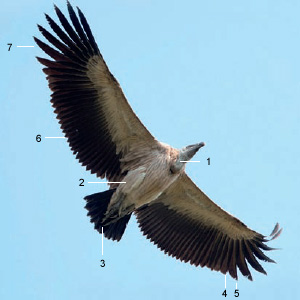Pratique | Identification
Première observation du Vautour indien au Népal

Vautour indien (Gyps indicus) juvénile, station de nourrissage de Pithauli, Népal, le 1er décembre 2011. Notez ((1) la tête et le cou recouverts de duvet blanc cotonneux, (2) le dessous du corps blanc beige uniforme, (3) les pattes n’atteignant pas l’extrémité de la queue bras élargi et bord de fuite de l’aile courbe en dents de scie, (4) et (5) la rémige primaire P3 légèrement digitée dont la longueur se rapproche de celle de la P4. D’autre part, chez le juvénile, les primaires (7) sont plus « anguleuses » que chez l’adulte et le bord de fuite est en « dents de scie » (6).Photographie : Robert DeCandido
Introduction
Le Népal, « coincé » entre la Chine et l’Inde, est le pays des plus hautes montagnes, mais aussi des vautours : le nombre d’espèces y est en effet le plus élevé du monde, malgré le très fort déclin qu’ils ont subi depuis le milieu des années 1990 à cause d’un produit vétérinaire désormais interdit, le diclofenac (un anti-inflammatoire destiné au bétail pour le traitement des inflammations et de la fièvre) : un rapace qui mangeait la carcasse d’une bête traitée était en effet exposé à des doses mortelles.
Le nombre d’espèces de vautours visibles au Népal est désormais de neuf depuis la découverte par Tulsi R. Subedi et Robert DeCandido le 1er décembre 2011 de deux Vautours indiens (Gyps indicus) dans la station de nourrissage de Pithauli, dans la zone-tampon du parc national de Chitwan. Nous vous proposons la version française de l’article qu’ils ont publié en 2013 dans le numéro 19 de la revue Birding Asia.
Abstract
Nepal, between China and India, is the country of the highest mountains of the world, but also of the vultures: their diversity is indeed the highest in the world despite the strong decline they have suffered since the mid-1990s due to the use of a veterinary product now banned, the diclofenac: it is an anti-inflammatory used for cattle for the treatment of inflammations and fever. A vulture eating the carcass of a treated animal was indeed exposed to lethal doses.
The number of species of vultures that can be found in Nepal now reaches nine since the discovery in December 2011 by Tulsi R. Subedi and Robert DeCandido of two Indian Vultures (Gyps indicus) in the feeding station of Pithauli, in the buffer zone of the Chitwan National Park. We propose you the French version of the article they published in 2013 in the issue 19 of the BirdingAsia Journal.
Poursuivez la lecture de cet article, en vous abonnant dès maintenant !
Découvrez les Archives d’Ornithomedia.com
Pour seulement 10,00 €TTC/an (ou 6,00 € les 6 mois)
Profitez de plusieurs centaines d’articles en accès illimité et sans aucun engagement.
Compléments
Contacts
Si vous souhaitez participer au suivi de la migration au Népal en 2014, vous pouvez contacter Robert DeCandido (e-mail : rdcny@earthlink.net) et/ou Tulsi Subedi (Tulsi.Biologist@gmail.com).
À lire aussi sur Ornithomedia.com
- Bilan 2012 du suivi de la migration des rapaces à Thoolakharka (Népal)
- Observer les vautours et les aigles dans la décharge de Jor Beed
- Un espoir pour les vautours du sous-continent indien
- Identifier le Vautour de Rüppell et le rechercher dans la péninsule ibérique
- Les « attaques » de vautours : fantasmes et réalités
Ouvrages recommandés
- Birds of India: Pakistan, Nepal, Bangladesh, Bhutan, Sri Lanka, and the Maldives de Richard Grimmett, Carol Inskipp et Tim Inskipp (2012)
- Guide du Routard Népal, Tibet 2012 de Collectif (2012)
- Nepal: the Rough Guide de David Reed
- Népal de Bradley Mayhew, Lindsay Brown et Trent Holden (2012)
- Le guide Ornitho de L. Svensson et al
- Guide des rapaces diurnes du monde de David-A Christie et al
Source
Subedi T. et DeCandido R. (2013). Indian Vulture Gyps indicus: first record for Nepal. BirdingASIA (19). Pages : 115–116




Aucun commentaire sur ce sujet
Participer à la discussion !